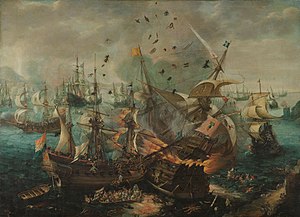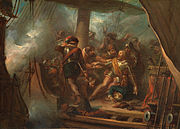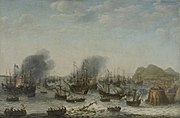Battle of Gibraltar (1607)
| Battle of Gibraltar | |||||||
|---|---|---|---|---|---|---|---|
| Part of the Eighty Years' War | |||||||
 Battle of Gibraltar by Cornelis van Wieringen | |||||||
| |||||||
| Belligerents | |||||||
 Dutch Republic Dutch Republic |  Spain Spain | ||||||
| Commanders and leaders | |||||||
| Jacob van Heemskerk † | Juan Álvarez de Avilés † | ||||||
| Strength | |||||||
| 26 warships |
| ||||||
| Casualties and losses | |||||||
|
| ||||||
- v
- t
- e
Western Europe
- Beeldenstorm
- Valenciennes
- Wattrelos
- Lannoy
- Oosterweel
- Dahlen
- Heiligerlee
- Jemmingen
- Jodoigne
- Le Quesnoy
Western Europe
- Brielle
- Mons
- 1st Mechelen
- Goes
- Naarden
- Middelburg
- Haarlem
- IJsselmeer
- Alkmaar
- 1st Geertruidenberg
- Leiden
- Delft
- Valkenburg
- Mookerheyde
- Oudewater
- Schoonhoven
- Zierikzee
- European waters
- Flushing
- Borsele
- Haarlemmermeer
- Zuiderzee
- Reimerswaal
- Lillo
Western Europe
- 1st Antwerp
- Gembloux
- Rijmenam
- 1st Deventer
- Borgerhout
Western Europe
- 1st Maastricht
- 2nd Mechelen
- Diest
- 1st Steenwijk
- Kollum
- 1st Breda
- Noordhorn
- Niezijl
- Lochem
- 1st Lier
- 2nd Antwerp
- Eindhoven
- Steenbergen
- Ghent
- Aalst
- 3rd Antwerp
- Arnhem
- Empel
- Boksum
- 1st Grave
- 1st Venlo
- Axel
- Neuss
- 1st Rheinberg
- 1st Zutphen
- 1st Sluis
- European waters
- Ten Years, 1588–1598
Western Europe
- 1st Bergen op Zoom
- 2nd Geertruidenberg
- 2nd Breda
- 2nd Zutphen
- 2nd Deventer
- Delfzijl
- Knodsenburg
- 1st Hulst
- Nijmegen
- Rouen
- Caudebec
- 2nd Steenwijk
- 1st Coevorden
- 1st Luxemburg
- 3rd Geertruidenberg
- 2nd Coevorden
- Groningen
- 2nd Luxemburg
- Huy
- 1st Groenlo
- Lippe
- 2nd Lier
- Calais
- 2nd Hulst
- Turnhout
- 2nd Rheinberg
- 1st Meurs
- 2nd Groenlo
- Bredevoort
- Enschede
- Ootmarsum
- 1st Oldenzaal
- 1st Lingen
- European waters
Western Europe
- 1st Schenckenschans
- Zaltbommel
- Rees
- San Andreas
- Lekkerbeetje
- Nieuwpoort
- 3rd Rheinberg
- Ostend
- 1st 's-Hertogenbosch
- 2nd Grave
- Hoogstraaten
- 3rd Sluis
- 2nd Lingen
- 3rd Groenlo
- European waters
- Dover Strait
- 2nd Sluis
- 1st Cape St. Vincent
- 1st Gibraltar
- Twelve Years' Truce, 1609–1621
Western Europe
- Aachen
East Indies
Western Europe
- Jülich
- 2nd Bergen op Zoom
- Fleurus
- 3rd Breda
- 2nd Oldenzaal
- 4th Groenlo
- 2nd 's-Hertogenbosch
- Meuse (2nd Maastricht)
- Leuven
- 2nd Schenkenschans
- 3rd Schenkenschans
- 4th Breda
- 2nd Venlo
- Roermond
- Kallo
- 3rd Hulst
- 4th Hulst
European waters
- 2nd Gibraltar
- 2nd Cádiz
- Slaak
- Lizard Point
- Dunkirk
- 2nd English Channel
- The Downs
- 2nd Cape St. Vincent
Americas
- 1st Salvador
- Puerto Rico
- Bay of Matanzas
- Abrolhos
- Trujillo · Campeche
- 1st Saint Martin
- 2nd Salvador
- Itamaracá
- Southern Chile
- 2nd Saint Martin
East Indies
The naval Battle of Gibraltar took place on 25 April 1607, during the Eighty Years' War, when a Dutch fleet surprised and engaged a Spanish fleet anchored at the Bay of Gibraltar. During the four hours of action, most of the Spanish ships were destroyed.
Forces
A Dutch fleet of 26 warships was led by Admiral Jacob van Heemskerk. The Dutch flagship was Æolus (of the Zeeland Admiralty). Other Dutch ships were De Roode Leeuw (also of the Zeeland Admiralty, and flagship of Vice-Admiral Laurens Jacobszoon Alteras), De Tijger (of the Maas Admiralty, and flagship of Rear-Admiral Lambert Hendrikszoon), De Zeehond, De Griffioen, De Gouden Leeuw, De Zwarte Beer, De Witte Beer, and De Ochtendster.
A Spanish fleet of 21 ships, including 10 galleons, was led by Don Juan Álvarez de Avilés. The Spanish flagship San Augustin was commanded by Don Juan's son. Other ships were Nuestra Señora de la Vega and Madre de Dios. The Spanish fleet was covered by a fortress, although the Dutch fleet was out of range of its guns at all times and the fortress guns were not able to affect the battle.[1]
Battle

Van Heemskerk left some of his ships at the bay entrance to prevent the escape of any Spanish ships. Twenty from the Dutch fleet were ordered to focus on the Spanish galleons while the rest attacked the smaller vessels.[2] Van Heemskerk was killed during the first approach on the Spanish flagship as a cannonball severed his leg. The Dutch then doubled up on the galleons and a few of the galleons caught fire. One exploded due to a shot that penetrated its powder magazine. The Dutch captured the Spanish flagship but let it go adrift.
Following the destruction of the Spanish ships, the Dutch deployed boats and killed hundreds of swimming Spanish sailors. The Dutch lost 100 men including Admiral Van Heemskerk. Sixty Dutch were wounded. Depending on the sources, most or all of the Spanish ships were lost and between 350 and 4,000 Spaniards were killed or captured. Álvarez de Avilés was amongst the dead.
Consequences
The battle was a leading driver of the Twelve Years' Truce, under which the Dutch Republic achieved de facto recognition by the Spanish Crown.
The battle had an important indirect effect on the History of Ireland, specifically the key event known as "Flight of the Earls". Hugh O'Neill, 2nd Earl of Tyrone, and Rory O'Donnell, 1st Earl of Tyrconnell, left Ulster in Ireland with the intention of getting a Spanish army to invade Ireland on their behalf. The destruction of the Spanish fleet ruled out any such option, and the Earls found themselves in irrevocable exile – with major consequences for the later history of Ireland, and especially of Ulster.
Gallery
Footnotes
Sources
- Fernández, C. (1898). Armada Española desde la unión de los reinos de Castilla y Aragón (in Spanish). Madrid: Rivedeneyra.
- Vere, F. (1955). Salt in their Blood: the lives of the famous Dutch admirals.
- De Jonge, J. C. Geschiedenis van het Nederlandse zeewezen (in Dutch).
- Akveld, L. M.; et al. (1973). Vier Eeuwen Varen (in Dutch).
- Warnsinck, J. C. M. (1941). Twaalf Doorluchtige Zeehelden (in Dutch).
External links
 Media related to Battle of Gibraltar (1607) at Wikimedia Commons
Media related to Battle of Gibraltar (1607) at Wikimedia Commons
36°08′20″N 5°23′55″W / 36.138887°N 5.398607°W / 36.138887; -5.398607

















